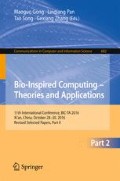Abstract
Traditional saliency detection models face great challenges towards low contrast images with low signal-to-noise ratio property. In this circumstance, it is difficult to extract effective visual features to describe salient information in image. This paper proposes a saliency detection model for low contrast images utilizing efficient features both from frequency domain and spatial domain. The input image is firstly transformed into frequency domain to calculate the amplitude spectrum by a median filter, aiming to suppress the information from non-salient regions. Then, a superpixel based feature extraction method is utilized to generate saliency map via both local and global spatial information. Experiments are carried on the low contrast image dataset to demonstrate the effectiveness of the proposed saliency detection model over other eight state-of-the-art saliency models.
Access this chapter
Tax calculation will be finalised at checkout
Purchases are for personal use only
References
Itti, L., Koch, C., Niebur, E.: A model of saliency-based visual attention for rapid scene analysis. IEEE Trans. Pattern Anal. Mach. Intell. 20(11), 1254–1259 (1998)
Harel, J., Koch, C., Perona, P.: Graph-based visual saliency. In: Advances in Neural Information Processing Systems, pp. 545–552 (2006)
Chen, S., Shi, W., Zhang, W.: Visual saliency detection via multiple background estimation and spatial distribution. Optik-Int. J. Light Electron Opt. 125(1), 569–574 (2014)
Wang, X., Ning, C., Xu, L.: Saliency detection using mutual consistency-guided spatial cues combination. Infrared Phys. Technol. 72, 106–116 (2015)
Hou, X., Zhang, L.: Saliency detection: a spectral residual approach. In: IEEE Conference on Computer Vision and Pattern Recognition, pp. 1–8 (2007)
Achanta, R., Hemami, S., Estrada, F., Susstrunk, S.: Frequency-tuned salient region detection. In: IEEE Conference on Computer Vision and Pattern Recognition, pp. 1597–1604 (2009)
Guo, C., Ma, Q., Zhang, L.: Spatio-temporal saliency detection using phase spectrum of quaternion fourier transform. In: IEEE Conference on Computer Vision and Pattern Recognition, pp. 1–8 (2008)
Chen, Z., Wang, X., Sun, Z., Wang, Z.: Motion saliency detection using a temporal fourier transform. Opt. Laser Technol. 80, 1–15 (2016)
Sun, X., Zhu, Z., Liu, X., Shang, Y., Yu, Q.: Frequency-spatial domain based salient region detection. Optik-Int. J. Light Electron Opt. 126(9–10), 942–949 (2015)
Chen, D., Jia, T., Wu, C.: Visual saliency detection: from space to frequency. Signal Process. Image Commun. 44, 57–68 (2016)
Mu, N., Xu, X., Chen, L., Tian, J.: Block-based salient region detection using a new spatial-spectral-domain contrast measure. In: IEEE International Symposium on Multimedia, pp. 86–89 (2014)
Achanta, R., Shaji, A., Smith, K., Lucchi, A., Fua, P., Susstrunk, S.: SLIC superpixels compared to state-of-the-art superpixel methods. IEEE Trans. Pattern Anal. Mach. Intell. 34(11), 2274–2282 (2012)
Murray, N., Vanrell, M., Otazu, X., Parraga, C.A.: Saliency estimation using a non-parametric low-level vision model. In: IEEE Conference on Computer Vision and Pattern Recognition, pp. 433–440 (2011)
Goferman, S., Zelnik-Manor, L., Tal, A.: Context-aware saliency detection. IEEE Trans. Pattern Anal. Mach. Intell. 34(10), 1915–1926 (2012)
Margolin, R., Tal, A., Zelnik-Manor, L.: What makes a patch distinct? In: IEEE Conference on Computer Vision and Pattern Recognition, pp. 1139–1146 (2013)
Zhu, W., Liang, S., Wei, Y., Sun, J.: Saliency optimization from robust background detection. In: IEEE Conference on Computer Vision and Pattern Recognition, pp. 2814–2821 (2014)
Tong, N., Lu, H., Yang, M.: Salient object detection via bootstrap learning. In: IEEE Conference on Computer Vision and Pattern Recognition, pp. 1884–1892 (2015)
Zhang, J., Wang, M., Zhang, S., Li, X., Wu, X.: Spatiochromatic context modeling for color saliency analysis. IEEE Trans. Neural Netw. Learn. Syst. 27(6), 1177–1189 (2016)
Acknowledgments
This work was supported by the Natural Science Foundation of China (61602349, 61373109, 61403287, 61602350 and 61273225) and the China Scholarship Council (201508420248).
Author information
Authors and Affiliations
Corresponding author
Editor information
Editors and Affiliations
Rights and permissions
Copyright information
© 2016 Springer Nature Singapore Pte Ltd.
About this paper
Cite this paper
Yang, H., Xu, X., Mu, N. (2016). Saliency Detection Model for Low Contrast Images Based on Amplitude Spectrum Analysis and Superpixel Segmentation. In: Gong, M., Pan, L., Song, T., Zhang, G. (eds) Bio-inspired Computing – Theories and Applications. BIC-TA 2016. Communications in Computer and Information Science, vol 682. Springer, Singapore. https://doi.org/10.1007/978-981-10-3614-9_56
Download citation
DOI: https://doi.org/10.1007/978-981-10-3614-9_56
Published:
Publisher Name: Springer, Singapore
Print ISBN: 978-981-10-3613-2
Online ISBN: 978-981-10-3614-9
eBook Packages: Computer ScienceComputer Science (R0)

